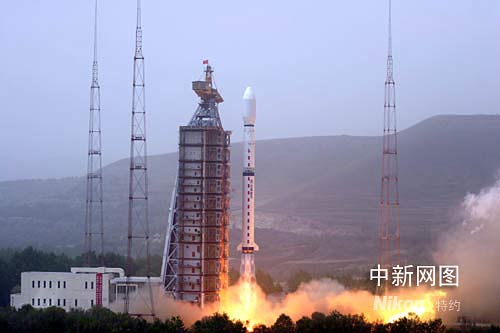China is stepping up its preparations for this year’s Olympics to be held in the Chinese capital, Beijing. Concern is growing for the start of the games this summer as early August is known to be a wet period in the region. More advanced weather satellites are therefore being sent into orbit to aid the forecasting effort. This is good timing for improved weather satellite technology as the earthquake-striken Sichuan province recovery effort has been hampered by poor weather conditions. Aid and search operations will greatly benefit from better weather forecasting…
At 11:02 Beijing Time (03:02 GMT) today, one of the most advanced weather satellites to be sent into space by China was launched from Taiyuan Satellite Launch Center in northern Shanxi Province. The satellite, called Fengyun-3, was launched by a Long March-4C carrier rocket. The ascent took 27 minutes from launch to orbital insertion.
This is the next generation in weather satellite technology for the nation. Fengyun-3 is carrying three-dimensional sensors that will measure the dynamics in the Earth’s atmosphere and climate. It will also monitor Polar Regions and ocean conditions. The sensors can measure temperature changes of 0.1F and has a spatial resolution of 250 meters (0.15 miles). This is a vast improvement on the resolution of its predecessors of only 1 kilometer (0.62 miles).
“The 250-m resolution images will be of vital significance for censoring global climate changes and possible subsequent natural disasters.” – Gao Huoshan, general director of the FY-3 research team.
Gao also describes Fengyun-3 as a key contributor to acquiring geographical data for aviation, navigation, agriculture, forestry and oceanography research. This impressive 2,295 kg (5,060 lb) satellite will be used extensively to aid weather predictions for the Olympics and will help disaster zones (such as the recent sequence of major earthquakes in the Sichuan province).
This is another Chinese success in space as the proud nation pushes for more development of homemade satellite technology. Since US rules barred the export of satellite components to China, there is a sense of urgency to develop their own direction in space. US rules do not seem to be restricting Chinese aspirations in space, China is planning for a manned Moon mission to launch soon after 2017.
Sources: China Daily, Physorg.com


With the second largest economy in the world, China was always going to bust into the space industry in a big way – and I really wouldn’t be surprised if it kicks off another cold war. Still, better that than an actual war…
On the upside, the likely outcome of a cold war is a commensurate increase in space faring technology as the two countries try to show off and out maneuver each other. Always look on the bright side of life…
Now THAT’S a way of looking art things I hadn’t considered..
Nice one, ‘Fiend!!